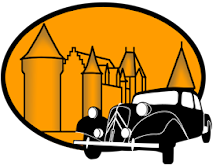To identify flies to family level use a simple wing venation key such as A Key to the Families of British
Diptera, an AIDGAP by D. Unwin, published by the FSC and available as a
free download (scroll down to the titles list) or a more detailed key which includes many physical characters such as The European Families of the Diptera by P. Oosterbroek. The expert dipterists on the DipteraInfo forum are also very happy to identify, often to species level, from good photographs.
Scientific Name: Volucella zonaria (Syrphidae Volucellini).
English Name: Hornet Mimic Hover Fly (Hover Fly family, Tribe Volucellini).
French Name:
5 Key Characters:
Lookalikes: Volucella inanis, which is smaller, does not have chestnut colouring and is yellow underneath, on sternite 2 (V. zonaria is black).
Habitat: Gardens and parks. Larvae live in social wasps' nests.
Flight Period: May-June-July-August-September-October-November.
Status: Fairly common.
Photographed by Loire Valley Nature:
Scientific Name: Volucella zonaria (Syrphidae Volucellini).
English Name: Hornet Mimic Hover Fly (Hover Fly family, Tribe Volucellini).
French Name:
5 Key Characters:
- one of the largest hover flies.
- yellow and black banded abdomen.
- thorax, scutellum (the little semi-circular part between the thorax and abdomen) and the second abdomenal segment (tergite 2/T2) are shiny and chestnut coloured.
- wings are orangey-yellow at the base and have a dark patch near the tip.
- comes indoors quite frequently.
Lookalikes: Volucella inanis, which is smaller, does not have chestnut colouring and is yellow underneath, on sternite 2 (V. zonaria is black).
Habitat: Gardens and parks. Larvae live in social wasps' nests.
Flight Period: May-June-July-August-September-October-November.
Status: Fairly common.
Photographed by Loire Valley Nature:
 |
| Male, foraging on Echinacea in a garden. |
 |
| Male, foraging on Echinacea in a garden. |
 |
| Male, foraging on Echinacea in a garden. |








I noticed this beautiful hoverfly yesterday afternoon in my garden on my giant daisies. Haven't seen it before here in Attika, Greece.
ReplyDeleteThey thrive in gardens. I used to get them even in London!
Delete